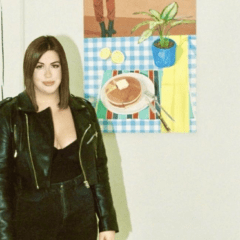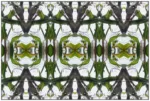I spent a week in London in August, and each day attempted to focus on a substantial outing, an interesting exhibition. My first jaunt was to cross Kensington Gardens to The Serpentine Gallery where the German artist Wolfgang Tillmans put on something of a retrospective, an expansive display of his alchemical results with photography. The 2000 Turner Prize winner, born in 1968, today a bona fide blue chip in the art world, offers a cornucopia of stolen, manipulated and performative photographic works in his first full-on exhibition in London in seven years. Each piece conspires to reveal the over-reproduced world we’re bound to while at the same time seeks some sort of philosophical escape from photography itself.
![Under An English Sky [Part I ] : Wolfgang Tillmans At The Serpentine Gallery, London 1 2010 serpentine 5](https://www.theartblog.org/wp-content/uploaded/2010_serpentine_5-300x200.jpg)
![Under An English Sky [Part I ] : Wolfgang Tillmans At The Serpentine Gallery, London 2 2010 serpentine 1](https://www.theartblog.org/wp-content/uploaded/2010_serpentine_1-300x200.jpg)
As I have little or no history in looking at Tillmans’ photography, I find myself surprised by the range of the works, their constantly shifting scale and their self-conscious rogue quality. One enters the beautiful spaces of the Serpentine to be confronted with four large unframed prints: A black and white portrait of raindrops pooled on a leaf; a standing female runner moments before the starting gun surrounded by flags, corporate logos and equipment; a blown up image of eggs in their cartons, and a home-made tacked-together shanty condo at twilight.
Tillmans’ essential project is immediately apparent: The observed and unobserved, something quite specific and practically uninteresting; his subjects lack any sort of personality but rather appear cloaked as a tool, an idea, locked into the environment. One almost has to ask: Why even take this picture? That, to me, seems to be the rationale for Tillmans’ project. He takes pictures and then, in an act to push the boundaries of the medium, systematically unravels nearly each and every aspect of the image, its support and its display. I can almost imagine Tillman floating his photographic finds in a vat of fixer on view in the next room.
![Under An English Sky [Part I ] : Wolfgang Tillmans At The Serpentine Gallery, London 3 Wolfgang Tillmans Blue in Perspex box 682x1024](https://www.theartblog.org/wp-content/uploaded/Wolfgang-Tillmans-Blue-in-Perspex-box-682x1024-199x300.jpg)
And true to form, a lineup of chemically exposed photographic papers, each bent and positioned like sculptures in Perspex (plastic) cases is just around the corner waiting in the next room. These 2008 works are immediately elegant in a minimalist way: in white and black and red and turquoise. From what I understand, Tillmans is a process monster and these pieces – as mundane as torn or bent metal – flesh out an important part of the photographer’s attempt to recast the rules of the darkroom and create objects out of exposed paper.
The next room is overwhelmed with two large digital prints that originated, I believe, in the laboratory. Tillman brandished a fibre-optic cable to “paint” with them on photographic paper. The results, enlarged and printed via inkjet, are more like 21st century Japanese aquarelles, like light traced in few watery arcs. The giant piece in red makes me think that Monet, if he turned minimalist in the 21st century, would be working with industrial light and magic in this manner. However, I also see them as conceptual performances, but beyond the possibilities intimated by these pieces of Internet light in this age of the iPhone, they sing a melancholy song. I can’t say why, they just do.
![Under An English Sky [Part I ] : Wolfgang Tillmans At The Serpentine Gallery, London 4 2010 serpentine 9](https://www.theartblog.org/wp-content/uploaded/2010_serpentine_9-300x200.jpg)
The next room brings together what is Tillmans’ signature installation style: variously-sized colored photographic papers (exposed, I assume using different filters) taped simply to the wall in an exacting way. The effect produced is a mosaic from floor to ceiling. You know you are looking at “photographs” but they function as formalist abstract color panels, an interior puzzle consisting of colored windows.
Tillman has long worked and reworked his installations; this room is completed by a series of a half-dozen wood shop-made viewing vitrines, each with a pages of newspapers, photocopy enlargements, text and other material culled from the image stream. On the walls are images of painters or window washers enlarged like giant photocopies, spied from a far while working on a building site. And to keep it all “real,” a giant and almost lovingly produced portrait of a piece photographic paper, rolled over onto itself. Tillman’s process is both “romantic” and ironic. I half expect a photograph of an enlarger; and indeed there is one of a photocopy machine.
![Under An English Sky [Part I ] : Wolfgang Tillmans At The Serpentine Gallery, London 5 2007 174 CLC1100](https://www.theartblog.org/wp-content/uploaded/2007-174-CLC1100-199x300.jpg)
There is also an intriguing image that the London press noted consistently as “homo-erotic” … Dan, from 2008. Here, the subject is a beautifully photographed naked red-haired man balancing his body while reaching for something on the ground, offering the intriguing illusion he has only a single leg. Dan is Olympian and classical, a minor god held within a lush green natural state. It was for me, the most well-wrought image in the entire show, and as such seemed an anomaly. But it’s not. Tillmans was early on hailed as the newish Nan Goldin, and this is but one of thousands of images the photographer has made of friends, mostly male.
![Under An English Sky [Part I ] : Wolfgang Tillmans At The Serpentine Gallery, London 6 Dan press image](https://www.theartblog.org/wp-content/uploaded/Dan-press-image-199x300.jpg)
As a final salute to clandestine image-making, an upskirt shot of a transvestite sans culottes (that’s without his Fruit of the Looms), is taped to the wall, so high up that your perspective is similar to the camera’s. You, the voyeur. (This image you’ll have to Google yourself!)
Tillmans is much more than a photographer; anyone who considers stained faxes part of the photographic canon is clearly working to push the possibilities of the medium towards the sky and beyond. But if Tillmans is after the “end of photography,” implicit in his installations, one needs to ask: Where does one stop? Tillman isn’t concerned, and his project can be seen as an idiosyncratic editing job with its own cursive logic. It’s a growing body of work of exhaustion, and that is the core of its sincerity. I’m reminded of the Carson McCullers’ book – and its multiple viewpoints – about a deaf man and the full catalog of people he encounters in a Georgia mill town in the 1930s: The Heart is a Lonely Hunter. Tillmans is in the end a protean image hunter, perhaps the loneliest of all.
Serpentine Gallery, June 26 – September 19, 2010.
http://www.serpentinegallery.org/
Kensington Gardens London W2 3XA
Wolfgang Tillmans Website
Matthew Rose is a artist and writer based in Paris. His next exhibition, SCARED BUT FRESH, opens at The Orange Dot Gallery in London on October 6, 2010. Click here to download the free poster.









